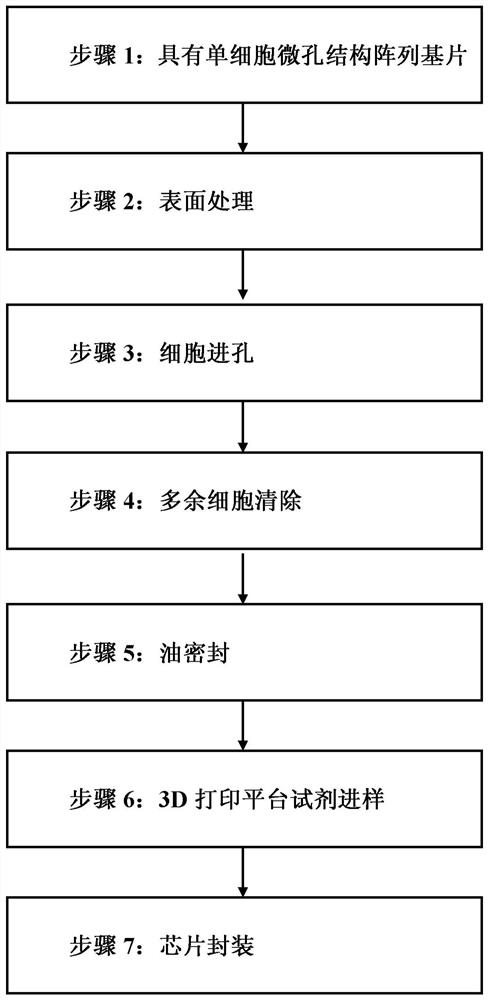Chip for open single cell research and preparation method thereof
A single-cell, open technology, applied in the field of single-cell research, can solve the problems of insufficient reagent volume of a single droplet, narrow application range, complex structure, etc., achieving fast and simple production steps, high single-cell occupancy, and flexible printing process. Effect
- Summary
- Abstract
- Description
- Claims
- Application Information
AI Technical Summary
Problems solved by technology
Method used
Image
Examples
preparation example Construction
[0042] Specifically, the preparation method of a novel open chip for single-cell research provided by the present invention includes the following steps: first, prepare a clean substrate with a single-cell microwell array, and use gravity to capture one cell per microwell. , and use sealing oil to isolate the micropores; then the 3D printing platform controls the nozzle to align the micropore reaction pools on the surface of the substrate to sequentially and quantitatively spray droplets, and the droplets penetrate the sealing oil and combine with the cells in the reaction pool; finally seal and fix , forming a packaged single-cell research chip.
[0043] see figure 1 and Figure 2A-2G As shown, the present invention provides an embodiment of a novel method for preparing a chip for open single-cell research, and the specific steps are as follows:
[0044] Step 1: Take a substrate 20 with a single-cell micropore structure array;
[0045] Step 2: surface-treating the substrat...
Embodiment 1
[0067] A chip for the proteomic analysis of human chronic myeloid leukemia cells (K562) single cells, the preparation method is as described above, wherein the aperture of the microholes of the microwell array structure of the substrate is 20 μm, and the interval between the microwells 100 μm; the cells are K562 cells, and a single K562 cell is captured in a microwell array by gravity; the K562 cells are sealed by using fluorinated oil as the sealing oil; the retaining wall uses PDMS, and the height of the retaining wall is 150 μm; , quantitative, and sequential printing methods, sequentially print cell lysate (phosphate-buffered saline solution containing 0.2 wt% TritonX-100 polyethylene glycol octylphenyl ether) and fluorescein substrate (2- β-D-galactopyranoside), the selected 3D printing platform is purchased from MicroFab Company of the United States Inkjet printing platform, the diameter of the nozzle is 50μm, and the printing parameters are set to be 40V pulse width an...
PUM
 Login to View More
Login to View More Abstract
Description
Claims
Application Information
 Login to View More
Login to View More - R&D
- Intellectual Property
- Life Sciences
- Materials
- Tech Scout
- Unparalleled Data Quality
- Higher Quality Content
- 60% Fewer Hallucinations
Browse by: Latest US Patents, China's latest patents, Technical Efficacy Thesaurus, Application Domain, Technology Topic, Popular Technical Reports.
© 2025 PatSnap. All rights reserved.Legal|Privacy policy|Modern Slavery Act Transparency Statement|Sitemap|About US| Contact US: help@patsnap.com



